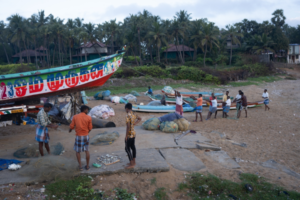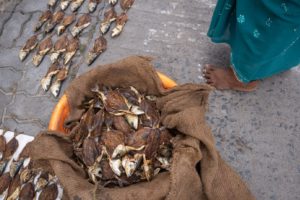Flowing parallel to the sea, marine sand resources are subject to erosional and extractive processes and thus interwoven with the socio-ecological dynamics at the land-sea interface. Sand resources are crucial not only as buffers against climate risk (e.g. cyclones) but also for the livelihood of small-scale fishing communities in South India.
Against this backdrop, the photography exhibition by IDOS researcher Dennis Schüpf combines in-depth fieldwork in cooperation with IFP (French Institute of Pondicherry) with visual storytelling to explore the role of sand resources for fishing communities and to communicate science to a broader audience beyond academia. The exhibition starts on 09 February and takes place at the IFP institute in Pondicherry. Photography as a means is used to put into perspective the beach, not only as a coastal space of recreation, but also as a site of labor. While the seascape with its beaches turns coastlines into a profitable space for tourism developers, traditional fishing hamlets depend upon access to the ever-shrinking beach spaces for their livelihood.
Access to the sandy beaches is the basis for their livelihood. Space is needed for boat landing and storage, boat repair and maintenance, catch drying, pulling and mending of nets as well as auctioning and selling of fish.  The exhibition also intends to visualise the absence of sand. Especially, female fish workers are unequally affected by the loss of sand due to less space for drying and selling fish. At the same time, rocks are dumped into the sea with the goal to protect property by stabilising the coast and preventing the shoreline from further erosion. Yet these technocratic adaptation hinder fish workers from accessing the sea and thus deepen their social vulnerability to climate and environmental changes at the coast.
The exhibition also intends to visualise the absence of sand. Especially, female fish workers are unequally affected by the loss of sand due to less space for drying and selling fish. At the same time, rocks are dumped into the sea with the goal to protect property by stabilising the coast and preventing the shoreline from further erosion. Yet these technocratic adaptation hinder fish workers from accessing the sea and thus deepen their social vulnerability to climate and environmental changes at the coast.
The exhibition is part of the Klimalog research project.

